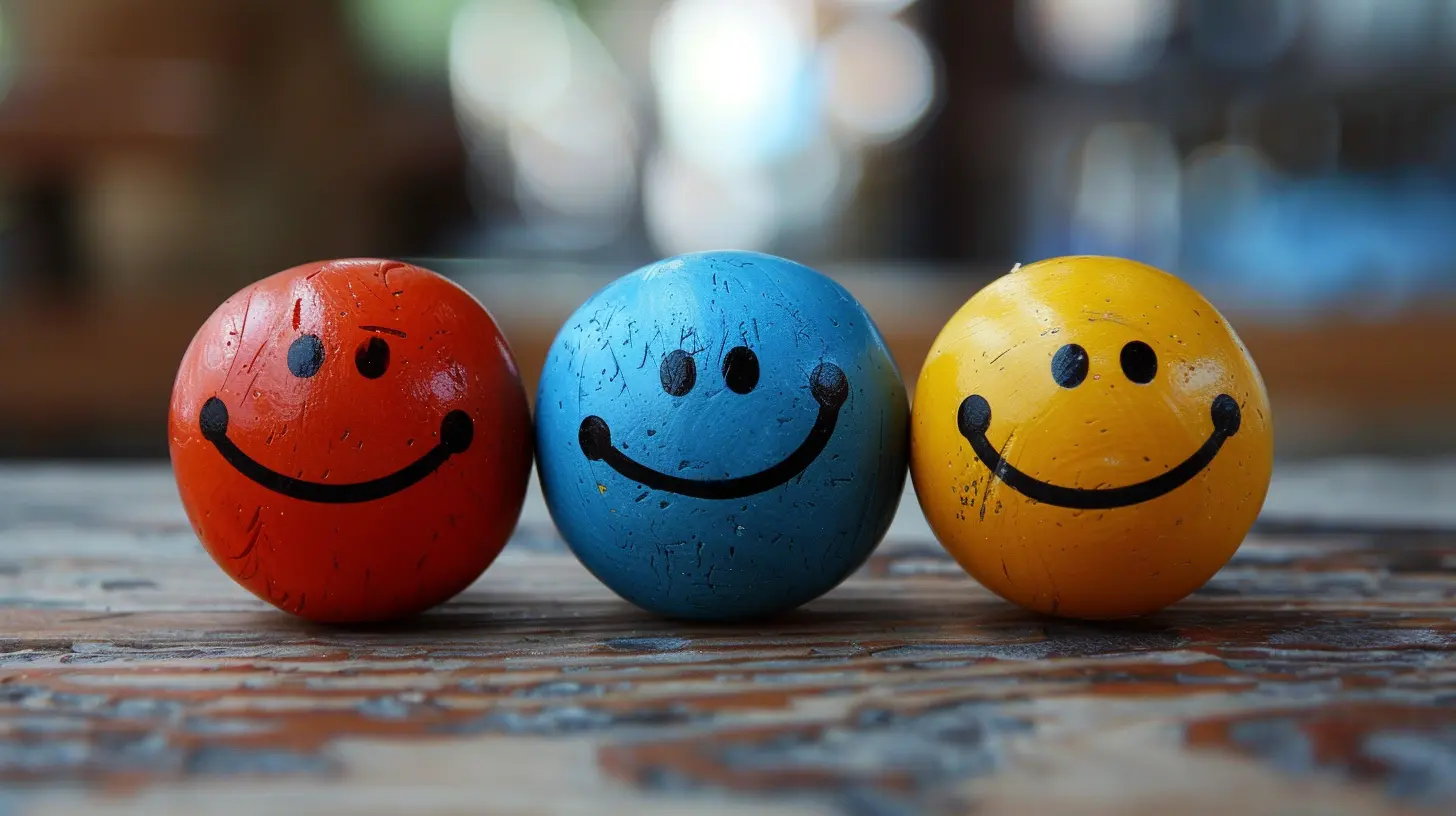The Science Behind Laughter: How Humor Affects Emotional Health
9 August 2025
Ah, laughter—a universal language that needs no translation. It sneaks in during awkward silences, bursts out during funny cat videos, and fills rooms during family dinners (usually thanks to Uncle Bob's questionable jokes). But have you ever stopped mid-chuckle and thought, “Wait, why do we even laugh?” And more importantly, “Is this laugh actually good for my health—or just my abs?”
Welcome to the ultimate brain-tickling, giggle-inducing guide to understanding how something as simple as a laugh can mess with your brain—in a good way.
What Even Is Laughter?
Let’s get this straight: laughter isn’t just a sound. It’s a full-body workout for your soul. Scientifically speaking, laughter is a complex physiological response involving dozens of muscles, the respiratory system, and—brace yourself—your brain being its sneaky, brilliant self.Imagine your brain as the wizard behind the curtain. It processes something humorous, sends signals to your face muscles, and boom—you sound like a squeaky accordion at a comedy night.
The Brain on Giggles: What Happens Upstairs?
When you laugh, your brain throws a full-on party. No confetti, but definitely fireworks. Here's a front-row seat to what's happening:1. The Prefrontal Cortex Gets the Joke
Think of this brain region as the “adult in the room.” It processes the logic and social context of a joke. If the joke is clever, this part goes, “Hmm, that pun is quite witty,” and gives the green light.2. The Amygdala and Hippocampus Join In
The amygdala handles emotions, and the hippocampus is like your brain’s librarian—it remembers everything. Together, they decide how emotionally funny or relatable something is. Essentially, these guys decide if you just smile or full-out snort.3. Dopamine Does Its Happy Dance
Laughing triggers the release of dopamine—our body's own feel-good, do-a-happy-dance chemical. It’s like natural Prozac, but without that long list of side effects. Dopamine reduces stress, boosts mood, and makes you feel like hugging strangers (but please don’t).
LOL = Lowered Stress Levels?
You betcha. Laughter punches stress right in the cortisol levels. Let me explain.Cortisol is the villain in your hormonal soap opera—it flares up during stress. Studies have shown that laughter reduces cortisol and increases endorphins (those are the happy little chemicals runners rave about).
So yes, watching just 15 minutes of a stand-up comedy special can be a full-on therapy session—for free. Your therapist might be offended, but your body will thank you.
Humor & Mental Health: Besties or Just Acquaintances?
Anxiety, Meet Your Match
Humor acts like a buffer for your brain. When life's throwing lemons at you, putting on your metaphorical clown nose can actually take the sting out of stress and anxiety. When you laugh, it’s harder for anxiety to rent space in your head.Depression Needs a Time-Out
Now, humor isn’t a cure-all. But it helps. A good laugh activates neural pathways that increase serotonin — the ultimate mood stabilizer. Not to mention, humor-based therapy is actually a real thing that shows promising results in lifting depressive moods.Builds Resilience Like a Boss
Laughter is kind of like emotional armor. People who use humor in tough times are often more resilient. They bounce back better, like emotional rubber balls. No crying in the corner—just a witty remark and moving on.Social Butterfly Fuel
Let’s face it—funny people are magnetic. Nobody says, “I met the most boring person today, I hope we become BFFs!” Humor builds social bonds, plain and simple.Laughter is contagious (yes, really contagious—like yawning but way more fun). It syncs up group rhythm, boosts relationships, and builds trust. It's also a social cue that says, “Hey, I like you, and we’re having fun!”
So, next time you awkwardly laugh in a meeting—congrats, you might’ve just bonded with your boss. (Or gotten written up, depending on your timing.)
Laughter as a Mini Workout (Yes, You Read That Right)
Okay, don’t cancel your gym membership just yet, but laughing actually gives your body a little physical boost.- Increased heart rate? Check.
- Boosted oxygen intake? Check.
- Muscle relaxation after a good belly laugh? Check.
A 15-minute laugh fest can even burn up to 40 calories. That’s one whole cookie, my friend. So feel free to eat dessert—just offset it with a comedy podcast.
Humor as a Coping Mechanism: Sarcasm, Wit, and Dad Jokes
Humor isn’t one-size-fits-all. There’s silly humor (looking at you, banana peel comedy), dry wit, self-deprecation, and yes—even dark humor. Each helps in different ways.- Self-deprecating humor helps you not take yourself too seriously.
- Sarcasm (used wisely) can highlight absurdities and make reality more palatable.
- Absurdist humor can offer escape when reality feels overwhelming.
So whether you giggle quietly or cackle like a gremlin, your brain is working overtime in the best way.
Laughter Yoga: Laughing Without a Punchline
Yes, it’s a thing, and no, you don’t need to know downward dog to join.Laughter yoga involves breathing exercises mixed with forced laughter, which often turns into real laughter. Because, honestly, it’s really hard not to laugh when everyone around you is fake laughing like maniacs.
And guess what? Your brain doesn’t care if the laughter is fake. It still releases the same happy chemicals. It’s like a biological loophole to happiness.
Can Humor Be…Too Much?
Look, too much of anything—even chocolate or nap time—can backfire.- Inappropriate humor can make people uncomfortable. Know your audience.
- Using humor to deflect serious emotions all the time? That’s emotional hide-and-seek.
- Laughing at others' expense? Not cool.
So yeah, laugh your heart out. Just don’t be a jerk about it.
Laughter Through Life Stages: From Giggles to Guffaws
Babies
Babies start laughing as early as 2-3 months. And they laugh around 300 times a day. That’s practically a stand-up special every 5 minutes.Teens
Teenagers use humor for social survival. Ever met a teen that doesn’t use sarcasm like it’s their first language? Didn’t think so.Adults
With responsibilities comes less laughter. Adults laugh around 15 times a day. That’s a serious drop from baby stats. Clearly, adulthood needs more memes.Older Adults
Studies show elderly folks who laugh more tend to have better mental and physical health. Retirement: official license to binge-watch sitcoms.Five Ridiculously Legit Reasons to Laugh More
1. Instant stress reducer – Better than punching a pillow (and less suspicious).2. Boosts immunity – Yes, your chuckle might actually fight off colds.
3. Enhances learning – Teachers, include jokes in your lectures. You’ll thank us later.
4. Raises pain tolerance – Laughter is nature’s ibuprofen.
5. Makes you more attractive – Science says people love funny folks. You’re welcome.
So, What’s the Punchline?
Humor isn’t just a party trick or a way to survive Aunt Linda’s holiday stories. It’s a legit brain-hack. It oils the gears in your noggin, strengthens your social muscles, and keeps emotional monsters like anxiety and sadness in check.Whether you're LOL-ing at memes, stifling a giggle at a boring meeting, or fake-laughing your way through laughter yoga, know this: you’re doing your brain and your heart (and maybe even your abs) a huge favor.
So go ahead—laugh like nobody’s watching. And if they are, maybe they’ll join you.
all images in this post were generated using AI tools
Category:
Emotional ExpressionAuthor:

Paulina Sanders
Discussion
rate this article
1 comments
Reagan Ward
Laughter is a powerful tool for emotional well-being. It reduces stress, boosts mood, and strengthens social connections. Incorporating humor into daily life can enhance overall mental health.
September 1, 2025 at 3:50 PM

Paulina Sanders
Absolutely! Laughter is indeed a vital component of emotional health, fostering resilience and connection while alleviating stress. Embracing humor can significantly enhance our overall well-being.


